cooling BMW X5 4.4I 2001 Owners Manual
[x] Cancel search | Manufacturer: BMW, Model Year: 2001, Model line: X5 4.4I, Model: BMW X5 4.4I 2001Pages: 223, PDF Size: 2.66 MB
Page 101 of 223

IndexDataTechnologyRepairsCar careControlsOverview
101n
Air conditioner 1 Airflow directed toward the wind-
shield and side windows
2 Airflow for the upper body
The side rotary dials allow you to
open and close the air supply
through an infinitely-variable range,
while the levers change the airflow
direction. The center rotary dial
controls the temperature of the air
as it flows out. Refer to page 103
3 Front footwell ventilation
4 Rear footwell ventilation
5 Air flow for the upper body in the
rear seat103
6 Temperature102
7 Air distribution toward
>the windows
>the upper body
>the footwell
An infinitely-variable range of
intermediate settings is also
available. Refer to page 102
8 Air supply102
The climate control is active when
the blower is switched on.
9 Rear window defroster73, 102
10 Cooling102
11 Recirculated air mode103
Page 102 of 223
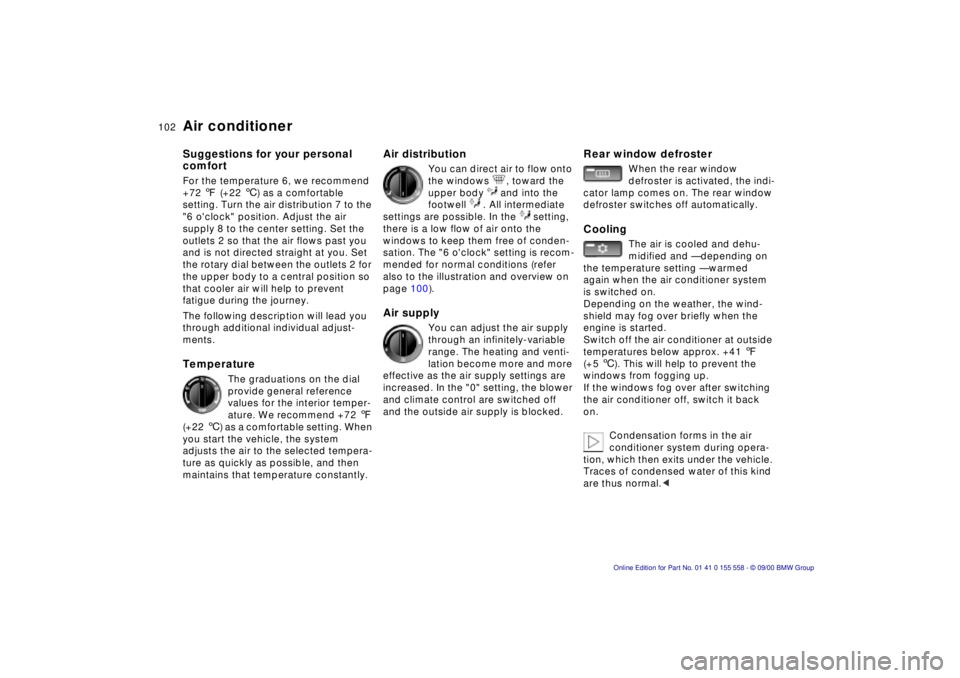
102n
Air conditioner Suggestions for your personal
comfortFor the temperature 6, we recommend
+72 7 (+22 6) as a comfortable
setting. Turn the air distribution 7 to the
"6 o'clock" position. Adjust the air
supply 8 to the center setting. Set the
outlets 2 so that the air flows past you
and is not directed straight at you. Set
the rotary dial between the outlets 2 for
the upper body to a central position so
that cooler air will help to prevent
fatigue during the journey.
The following description will lead you
through additional individual adjust-
ments.Temperature
The graduations on the dial
provide general reference
values for the interior temper-
ature. We recommend +72 7
(+22 6) as a comfortable setting. When
you start the vehicle, the system
adjusts the air to the selected tempera-
ture as quickly as possible, and then
maintains that temperature constantly.
Air distribution
You can direct air to flow onto
the windows , toward the
upper body and into the
footwell . All intermediate
settings are possible. In the setting,
there is a low flow of air onto the
windows to keep them free of conden-
sation. The "6 o'clock" setting is recom-
mended for normal conditions (refer
also to the illustration and overview on
page 100).
Air supply
You can adjust the air supply
through an infinitely-variable
range. The heating and venti-
lation become more and more
effective as the air supply settings are
increased. In the "0" setting, the blower
and climate control are switched off
and the outside air supply is blocked.
Rear window defroster
When the rear window
defroster is activated, the indi-
cator lamp comes on. The rear window
defroster switches off automatically.
Cooling
The air is cooled and dehu-
midified and — depending on
the temperature setting — warmed
again when the air conditioner system
is switched on.
Depending on the weather, the wind-
shield may fog over briefly when the
engine is started.
Switch off the air conditioner at outside
temperatures below approx. +41 7
(+5 6). This will help to prevent the
windows from fogging up.
If the windows fog over after switching
the air conditioner off, switch it back
on.
Condensation forms in the air
conditioner system during opera-
tion, which then exits under the vehicle.
Traces of condensed water of this kind
are thus normal.<
Page 104 of 223
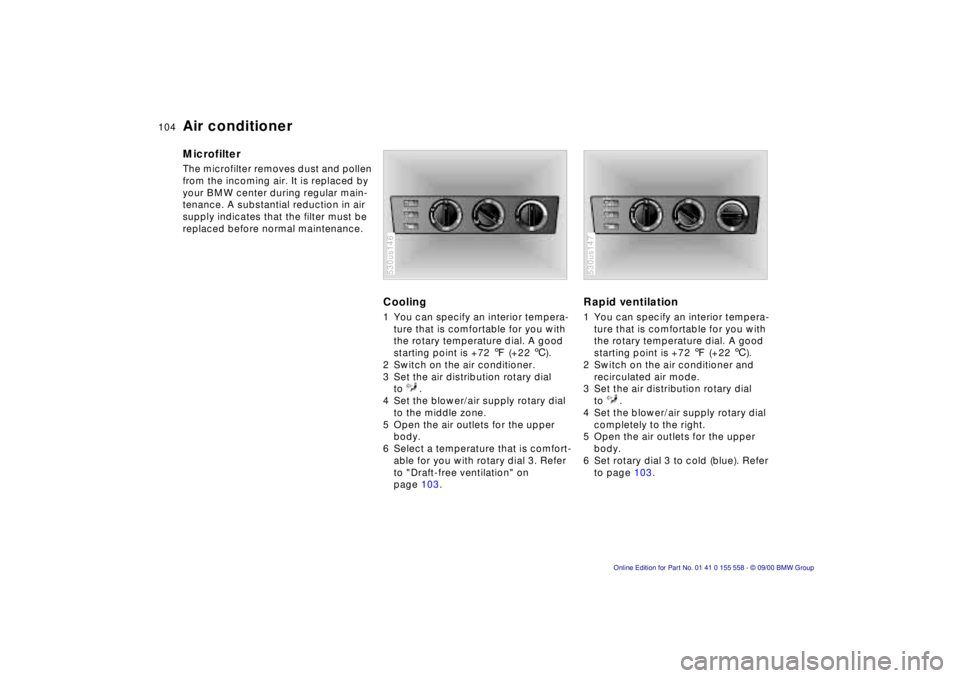
104n
Air conditionerMicrofilter The microfilter removes dust and pollen
from the incoming air. It is replaced by
your BMW center during regular main-
tenance. A substantial reduction in air
supply indicates that the filter must be
replaced before normal maintenance.
Cooling1 You can specify an interior tempera-
ture that is comfortable for you with
the rotary temperature dial. A good
starting point is +72 7 (+22 6).
2 Switch on the air conditioner.
3 Set the air distribution rotary dial
to .
4 Set the blower/air supply rotary dial
to the middle zone.
5 Open the air outlets for the upper
body.
6 Select a temperature that is comfort-
able for you with rotary dial 3. Refer
to "Draft-free ventilation" on
page 103.530us146
Rapid ventilation1 You can specify an interior tempera-
ture that is comfortable for you with
the rotary temperature dial. A good
starting point is +72 7 (+22 6).
2 Switch on the air conditioner and
recirculated air mode.
3 Set the air distribution rotary dial
to .
4 Set the blower/air supply rotary dial
completely to the right.
5 Open the air outlets for the upper
body.
6 Set rotary dial 3 to cold (blue). Refer
to page 103.530us147
Page 107 of 223
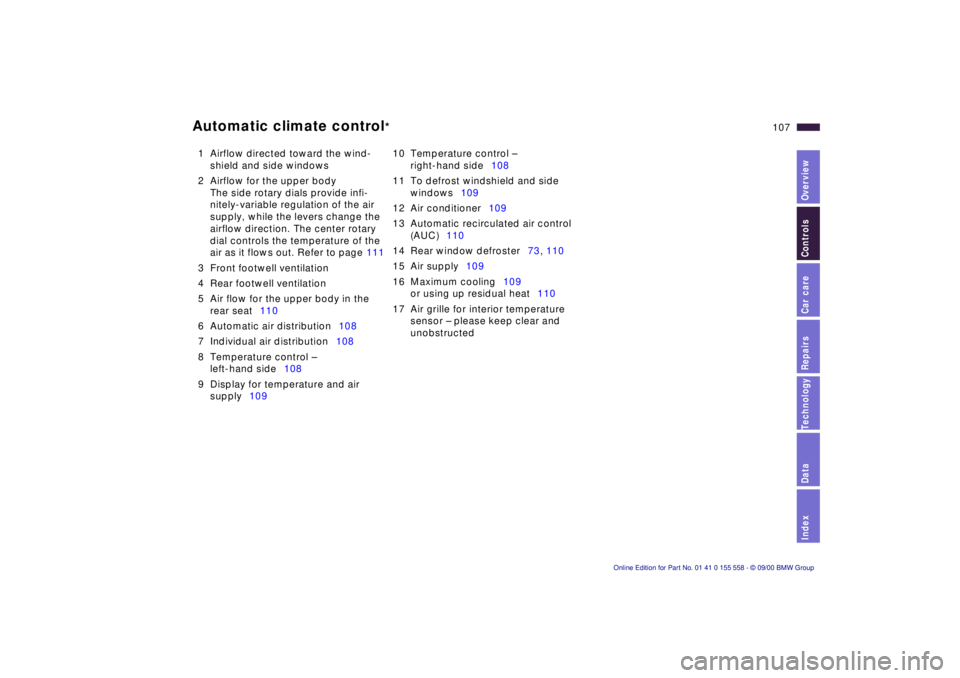
IndexDataTechnologyRepairsCar careControlsOverview
107n
Automatic climate control
*
1 Airflow directed toward the wind-
shield and side windows
2 Airflow for the upper body
The side rotary dials provide infi-
nitely-variable regulation of the air
supply, while the levers change the
airflow direction. The center rotary
dial controls the temperature of the
air as it flows out. Refer to page 111
3 Front footwell ventilation
4 Rear footwell ventilation
5 Air flow for the upper body in the
rear seat110
6 Automatic air distribution108
7 Individual air distribution108
8 Temperature control –
left-hand side108
9 Display for temperature and air
supply10910 Temperature control –
right-hand side108
11 To defrost windshield and side
windows109
12 Air conditioner109
13 Automatic recirculated air control
(AUC)110
14 Rear window defroster73, 110
15 Air supply109
16 Maximum cooling109
or using up residual heat110
17 Air grille for interior temperature
sensor – please keep clear and
unobstructed
Page 108 of 223
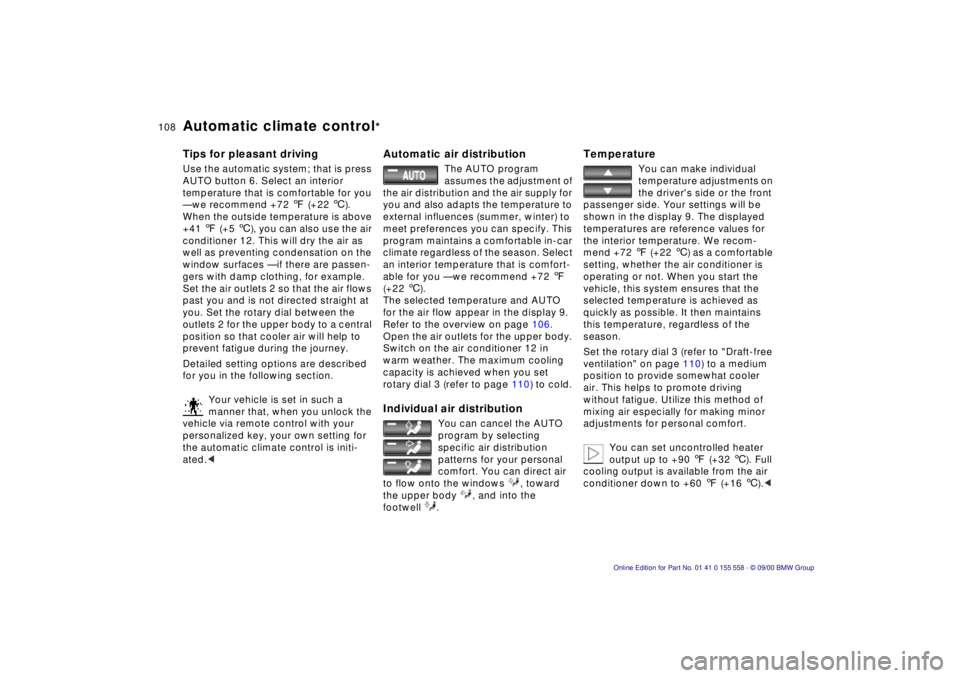
108n
Automatic climate control
*
Tips for pleasant drivingUse the automatic system; that is press
AUTO button 6. Select an interior
temperature that is comfortable for you
— we recommend +72 7 (+22 6).
When the outside temperature is above
+41 7 (+5 6), you can also use the air
conditioner 12. This will dry the air as
well as preventing condensation on the
window surfaces — if there are passen-
gers with damp clothing, for example.
Set the air outlets 2 so that the air flows
past you and is not directed straight at
you. Set the rotary dial between the
outlets 2 for the upper body to a central
position so that cooler air will help to
prevent fatigue during the journey.
Detailed setting options are described
for you in the following section.
Your vehicle is set in such a
manner that, when you unlock the
vehicle via remote control with your
personalized key, your own setting for
the automatic climate control is initi-
ated.<
Automatic air distribution
The AUTO program
assumes the adjustment of
the air distribution and the air supply for
you and also adapts the temperature to
external influences (summer, winter) to
meet preferences you can specify. This
program maintains a comfortable in-car
climate regardless of the season. Select
an interior temperature that is comfort-
able for you — we recommend +72 7
(+22 6).
The selected temperature and AUTO
for the air flow appear in the display 9.
Refer to the overview on page 106.
Open the air outlets for the upper body.
Switch on the air conditioner 12 in
warm weather. The maximum cooling
capacity is achieved when you set
rotary dial 3 (refer to page 110) to cold.
Individual air distribution
You can cancel the AUTO
program by selecting
specific air distribution
patterns for your personal
comfort. You can direct air
to flow onto the windows , toward
the upper body , and into the
footwell .
Temperature
You can make individual
temperature adjustments on
the driver's side or the front
passenger side. Your settings will be
shown in the display 9. The displayed
temperatures are reference values for
the interior temperature. We recom-
mend +72 7 (+22 6) as a comfortable
setting, whether the air conditioner is
operating or not. When you start the
vehicle, this system ensures that the
selected temperature is achieved as
quickly as possible. It then maintains
this temperature, regardless of the
season.
Set the rotary dial 3 (refer to "Draft-free
ventilation" on page 110) to a medium
position to provide somewhat cooler
air. This helps to promote driving
without fatigue. Utilize this method of
mixing air especially for making minor
adjustments for personal comfort.
You can set uncontrolled heater
output up to +90 7 (+32 6). Full
cooling output is available from the air
conditioner down to +60 7 (+16 6).<
Page 109 of 223
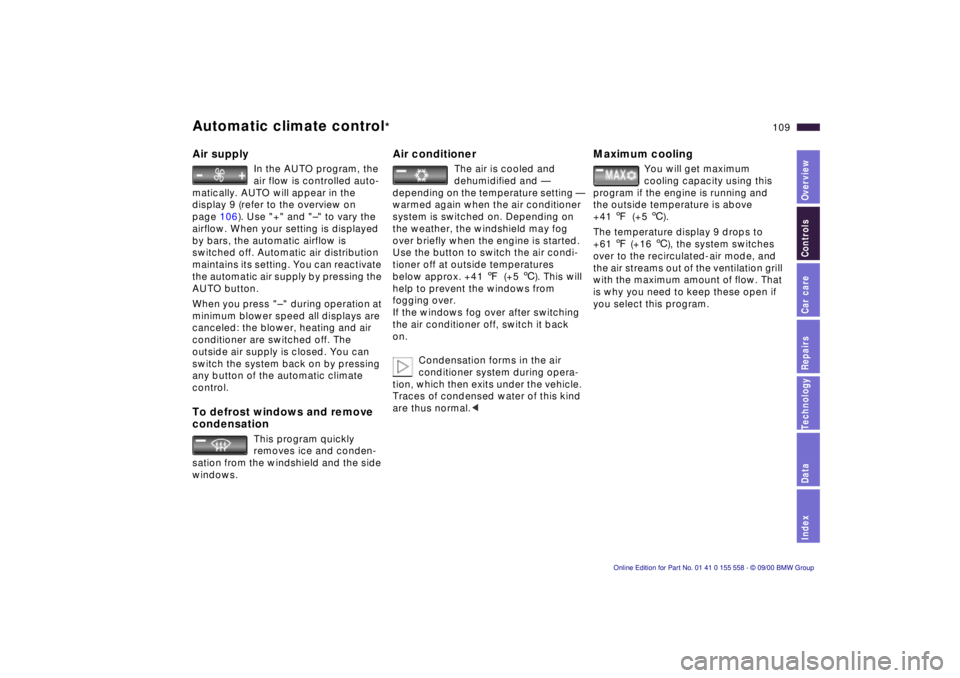
IndexDataTechnologyRepairsCar careControlsOverview
109n
Automatic climate control
*
Air supply
In the AUTO program, the
air flow is controlled auto-
matically. AUTO will appear in the
display 9 (refer to the overview on
page 106). Use "+" and "–" to vary the
airflow. When your setting is displayed
by bars, the automatic airflow is
switched off. Automatic air distribution
maintains its setting. You can reactivate
the automatic air supply by pressing the
AUTO button.
When you press "– " during operation at
minimum blower speed all displays are
canceled: the blower, heating and air
conditioner are switched off. The
outside air supply is closed. You can
switch the system back on by pressing
any button of the automatic climate
control.
To defrost windows and remove
condensation
This program quickly
removes ice and conden-
sation from the windshield and the side
windows.
Air conditioner
The air is cooled and
dehumidified and —
depending on the temperature setting —
warmed again when the air conditioner
system is switched on. Depending on
the weather, the windshield may fog
over briefly when the engine is started.
Use the button to switch the air condi-
tioner off at outside temperatures
below approx. +41 7(+5 6). This will
help to prevent the windows from
fogging over.
If the windows fog over after switching
the air conditioner off, switch it back
on.
Condensation forms in the air
conditioner system during opera-
tion, which then exits under the vehicle.
Traces of condensed water of this kind
are thus normal.<
Maximum cooling
You will get maximum
cooling capacity using this
program if the engine is running and
the outside temperature is above
+41 7(+5 6).
The temperature display 9 drops to
+61 7 (+16 6), the system switches
over to the recirculated-air mode, and
the air streams out of the ventilation grill
with the maximum amount of flow. That
is why you need to keep these open if
you select this program.
Page 160 of 223

160n
Coolant
Do not add coolant to the cooling
system when the engine is hot. If
you attempt to do so, escaping coolant
can cause burns.
To avoid the possibility of damage later
on, never use anything other than
factory-approved, nitrite and amino-
free extended-duty antifreeze with
corrosion inhibitor. Your BMW center is
familiar with the factory specifications.
Antifreeze and anticorrosion agents are
hazardous to health. You should always
store them in their original container
and in a location which is inaccessible
to children.
Extended-duty antifreeze with corro-
sion inhibitor contains the flammable
substance ethylene–glycol. For this
reason, do not spill antifreeze with
corrosion inhibitor on hot engine parts.
It could ignite and cause serious
burns.<
Comply with the applicable envi-
ronmental laws regulating the
disposal of extended-duty antifreeze
with corrosion inhibitor.<
Checking coolant levelCorrect coolant level when the engine
is cold approx. +68 7(+20 6):
Unscrew the cap from the expansion
tank.
The coolant level is correct when the
end of the red float is aligned with the
upper edge of the filler opening (refer to
the arrow in the illustration), or max.
0.8 in (2 cm) higher, i. e. up to the mark
on the float (refer also to the schematic
diagramm, next to the cap).530us102
Adding coolant Wait until the engine cools before
removing the cap from the expansion
tank. The needle of the coolant temper-
aturegauge in the instrument cluster
must be located in the blue zone. If it is
not, there is a danger of scalding.
1 Start by turning the cap counter-
clockwise. Pause to allow any accu-
mulated pressure to escape, then
open the cap.
2 If the coolant is low, slowly add
coolant until the correct level is
reached — do not overfill.
The coolant is a mixture of water
and extended-duty antifreeze with
corrosion inhibitor. Always maintain the
prescribed all-season 50:50 mixture
ratio for year-round protection against
internal corrosion. No other additives
are required.
Replace the coolant every four years.
Page 209 of 223

Index
Data
Technology
Repairs
Car care
Controls
Overview
209nCapacities
Notes
Fuel tank
Reserve gal. (liters)
gal. (liters)approx. 24.6 (approx. 93)
approx. 2.0 (approx. 8) – BMW X5 3.0i
approx. 2.5 (approx. 10) – BMW X5 4.4i Fuel specification: page
30
Windshield washer system
with headlamp washer system quarts (liters) approx. 8.2 (approx. 7.8) For details: page
156
Cooling system including
heater circuit quarts (liters) 11.1 (10.5) – BMW X5 3.0i
12.7 (12.0) – BMW X5 4.4i For details: page
160
Engine oil and filter change quarts (liters) 7.9 (7.5) – BMW X5 3.0i 8.5 (8.0) – BMW X5 4.4i"BMW High Performance
Synthetic Oil"
For details: page
158
Manual and automatic transmission,
transfer box and differential – – Lifetime fluid, no fluid
change required
Page 217 of 223
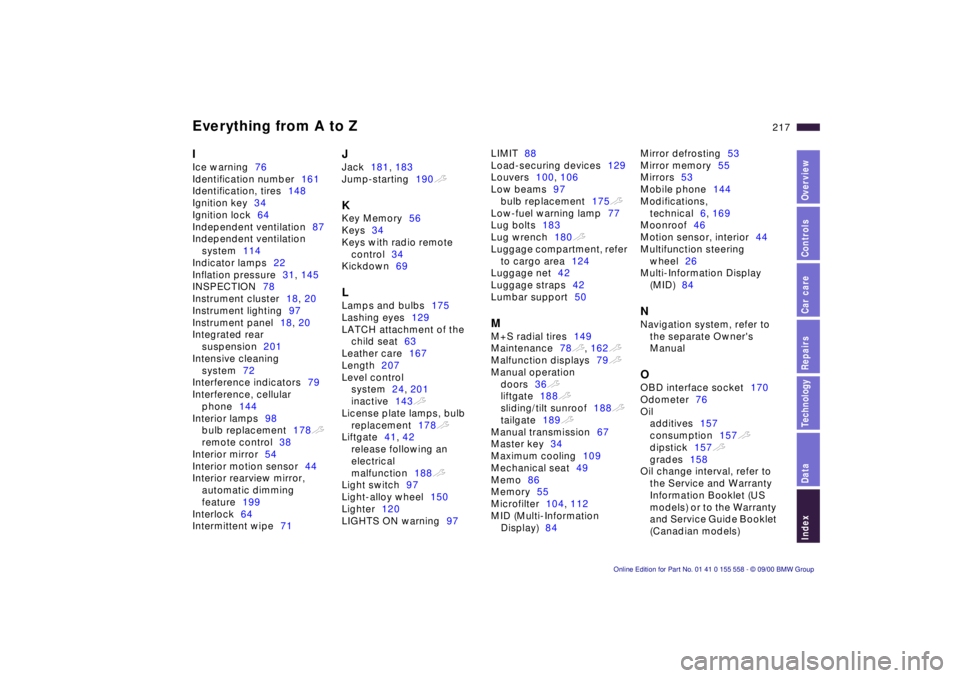
Everything from A to Z217n
Index
Data
Technology
Repairs
Car care
Controls
Overview
I
Ice warning 76
Identification number 161
Identification, tires 148
Ignition key 34
Ignition lock 64
Independent ventilation 87
Independent ventilation system 114
Indicator lamps 22
Inflation pressure 31, 145
INSPECTION 78
Instrument cluster 18, 20
Instrument lighting 97
Instrument panel 18, 20
Integrated rear suspension 201
Intensive cleaning system 72
Interference indicators 79
Interference, cellular phone 144
Interior lamps 98
bulb replacement 178t
remote control 38
Interior mirror 54
Interior motion sensor 44
Interior rearview mirror, automatic dimming
feature 199
Interlock 64
Intermittent wipe 71
J
Jack181, 183
Jump-starting 190t
K
Key Memory 56
Keys 34
Keys with radio remote control 34
Kickdown 69
L
Lamps and bulbs 175
Lashing eyes 129
LATCH attachment of the child seat 63
Leather care 167
Length 207
Level control system 24, 201
inactive 143t
License plate lamps, bulb replacement 178t
Liftgate 41, 42
release following an
electrical
malfunction 188t
Light switch 97
Light-alloy wheel 150
Lighter 120
LIGHTS ON warning 97LIMIT
88
Load-securing devices 129
Louvers 100, 106
Low beams 97
bulb replacement 175t
Low-fuel warning lamp 77
Lug bolts 183
Lug wrench 180t
Luggage compartment, refer to cargo area 124
Luggage net 42
Luggage straps 42
Lumbar support 50
M
M+S radial tires149
Maintenance 78t , 162 t
Malfunction displays 79t
Manual operation doors 36t
liftgate 188t
sliding/tilt sunroof 188t
tailgate 189t
Manual transmission 67
Master key 34
Maximum cooling 109
Mechanical seat 49
Memo 86
Memory 55
Microfilter 104, 112
MID (Multi-Information Display) 84 Mirror defrosting
53
Mirror memory 55
Mirrors 53
Mobile phone 144
Modifications, technical 6, 169
Moonroof 46
Motion sensor, interior 44
Multifunction steering wheel 26
Multi-Information Display (MID) 84
N
Navigation system, refer to
the separate Owner's
Manual
O
OBD interface socket 170
Odometer 76
Oil additives 157
consumption 157t
dipstick 157t
grades 158
Oil change interval, refer to
the Service and Warranty
Information Booklet (US
models) or to the Warranty
and Service Guide Booklet
(Canadian models)